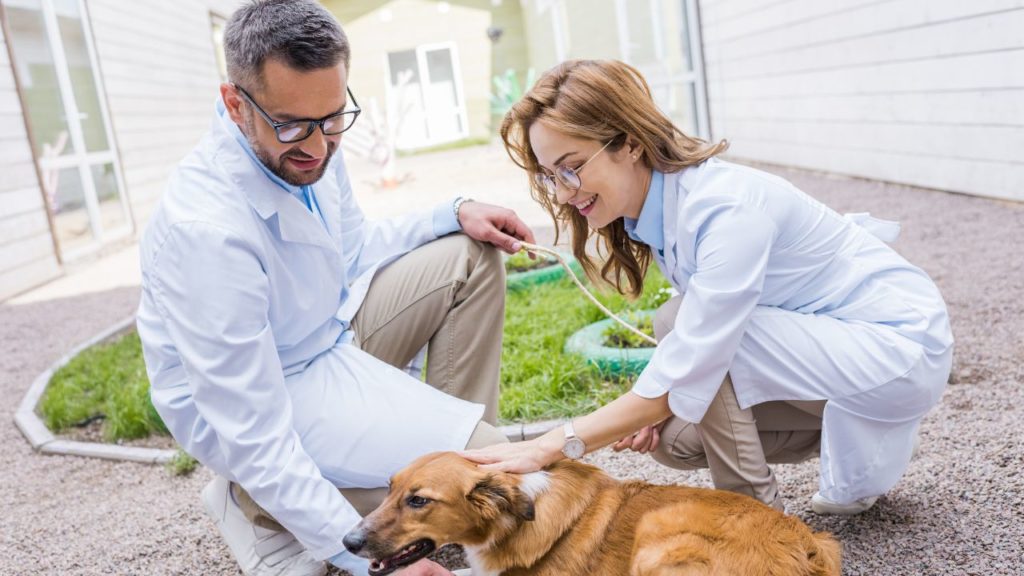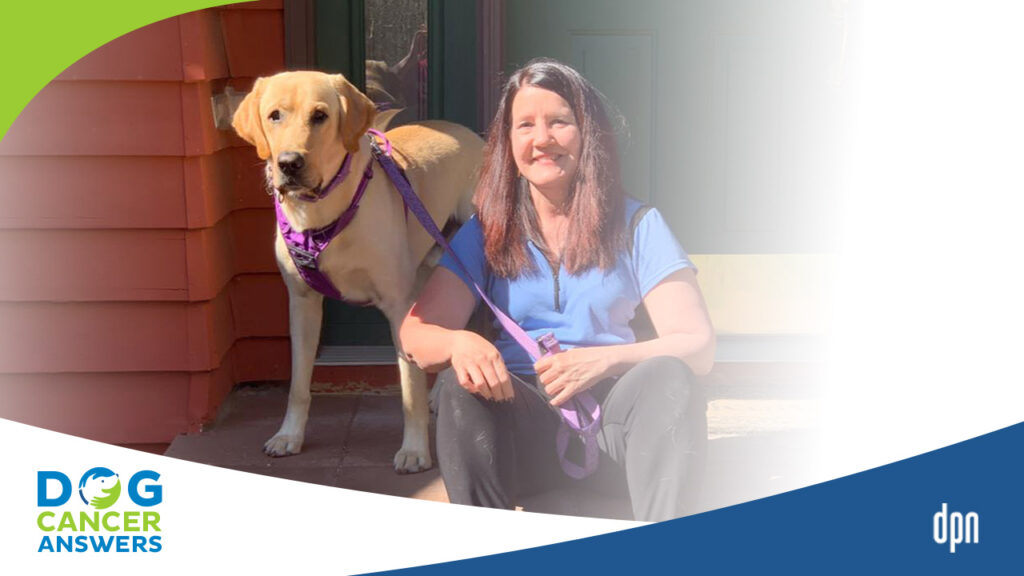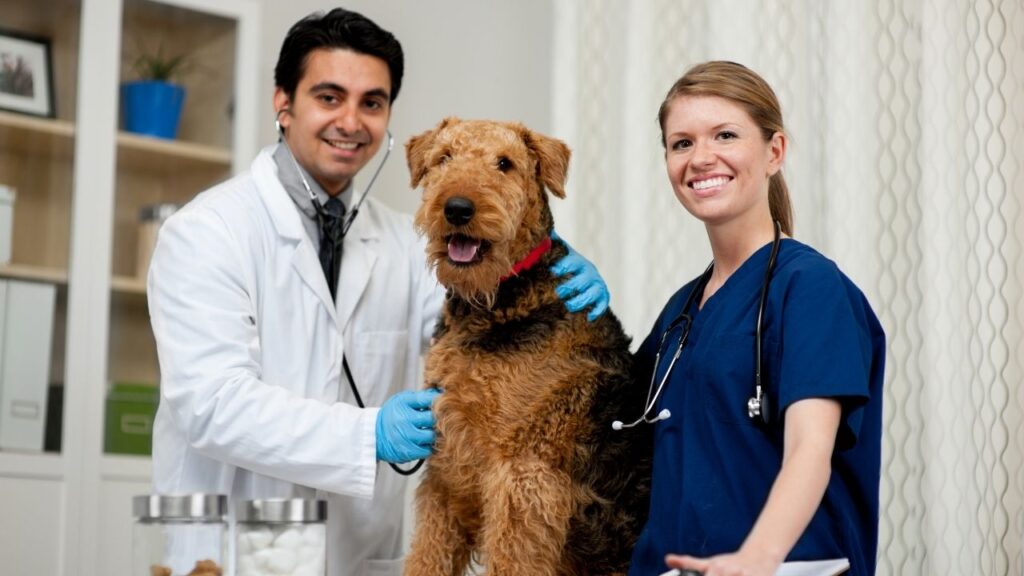When a crisis happens – such as your dog being diagnosed with cancer -- it can be devastating in so many ways. The best way to find success for both you and your dog is to face this crisis together, with you at the lead.
Key Takeaways
- You do not have to do what your vet says. Your vet is giving their best advice based on their education and experience, but the “best option” is not always the best option for every person and dog.
- You can say no to a vet but be polite and respectful. They are people too!
- It is perfectly OK to get a second opinion from another vet.
Team Leader = Primary Health Advocate
In human medicine, patient advocacy is so important that it is often an official position in human hospitals and health clinics. With animals, the role of primary health advocate may not be so formal, but it’s no less important.
And surprise, it’s you!
You know your dog best. You are her voice and her best advocate. You will be the one to lead her healthcare team to success.
Your Dog’s Team
First, you must build your dog’s healthcare team, which you have likely already started doing.2 Your dog’s healthcare team includes:
- You
- Any other caregivers or family members
- Your dog’s regular veterinarian(s)
- Your dog’s oncologist(s) and other veterinary specialists
- Your dog’s veterinary technicians, assistants, nurses, and other support staff
- Your online resources, such as Facebook groups and support teams
That’s a lot of people, but the top of this list is you. You are the quarterback, team captain, president, and prime minister. Final decisions go through you and any co-captains you may designate. Utilize your team. Take their advice. Their education and experience are valuable resources, but it is your responsibility to understand what they tell you and to make it happen.
Your Job as Team Leader
As your dog’s healthcare team leader, you have the biggest responsibilities:
- Keep the team members informed with each other.
- Keep the team members informed of changes at home.
- Understand what the medical team members are telling you, and how it affects your dog.
- Make decisions for what your dog would want.
- Provide the best nursing care.
- Make each day as good as it can be for your dog.
New Skills
This may sound like a lot, and it is. You will likely need to learn some new skills to support your dog in this challenging time:
- Critical thinking. Your team members may not always agree with each other, or with you. You must learn to collect information from your expert team, ask intelligent questions, and use logic to apply it.
- Communication skills. You must learn to speak up, ask questions, and follow up. This can especially be hard if you are naturally shy. Communication also includes being patient and kind to your team members.
- Nursing skills. As your dog’s health declines, you may need to learn how to change bandages, give medication, evaluate for pain, and other caretaker skills.
- Medical terminology and basic medical knowledge. Unless you are already in the medical industry, there will likely be a lot of new things to learn. Use accurate resources, websites, and books recommended by your trusted healthcare team to educate yourself. Ask a lot of questions.
- Balancing your emotions, stress, and self-care. Someone you love is very sick and that can be hard for you, too. It takes practice and mindfulness to recognize your own emotions, take care of your own needs, and to not take your stress out on others.
Your Dog’s Goals
As you, your dog, and your dog’s healthcare team proceed together, take some time to figure out your dog’s goals. When times get tough, or confusing, it can be helpful to have some kind of a plan — or at least some common objectives. Here are some questions to think about, but ask yourself, “What would my dog want?”
Are we looking for aggressive, gold-standard cancer care?
Or are we looking for supportive care, palliative care, and/or to maintain quality of life?
How do we know what each looks like, where to draw the line, and when to shift gears?
Do we have financial concerns? If so, what is our financial limit? Do we have a plan for financial assistance if needed?
Does either of us have stress, anxiety, and comfort concerns? Do we have a plan for making each day count (such as daily walks, favorite treats, massages, favorite daily games, and routines)?
Do we want to focus on alternative treatments, traditional treatments, or both?
If you know the answer to these questions, or at least have some kind of idea, it will help you make decisions in the near future.
Your Dog’s Comfort
Most people agree that the most important goal is to maintain quality of life – being mentally, emotionally, and physically content, comfortable, and free of pain – even throughout a medical crisis. That may be a tall order when your dog is fighting cancer, but you can help make that happen for her.
Your dog’s veterinarians and veterinary technicians can help you recognize some signs of pain and discomfort, but remember that dogs can act strangely while at the veterinary clinic. You know your dog better than anyone. You know her personality, normal behavior, and her likes and dislikes. Together, you can decide if your dog is in pain or uncomfortable at home, and what to do about it.
Here are two resources to help you gauge your dog’s level of pain:
- Colorado State University Canine Acute Pain Scale5
- American Animal Hospital Association How to Tell if Your Dog is in Pain4
Pain can be very complex and is not always so easy to evaluate. There are different kinds of pain – acute (quick onset) and chronic (slow onset), visceral (the dull, achy pain of the internal organs) and somatic (the sharper pain of bones, joints, muscles, and skin). Dogs don’t always show pain.1,3 And some pain symptoms – such as panting, pacing, or behavior changes – can resemble anxiety or cognitive dysfunction.
If you’re unsure if your dog is in pain, put yourself in her paws. Would whatever she is experiencing be painful to you? If so, give her the benefit of pain control. When in doubt, go ahead and let your veterinarian know you think your dog is in pain or discomfort.
Obvious pain symptoms in dogs:
- Yelping or crying
- Limping
- Large tumors or sores
Subtle pain symptoms in dogs:
- Moving slower
- Lethargy
- Sleeping more
- Eating less
- Not caring about the activities she usually enjoys
- Overgrooming a specific area on her body
- Don’t want to be touched (petted, picked up, groomed)
Don’t forget you are in charge of your dog’s mental and emotional health as well as her physical health. Keeping up with your favorite routines and activities as long as possible and adjusting them as her health needs change (for example, taking her out in a wagon when she can’t walk) will help both of you keep in good spirits.
Set an example for your dog. She may know something is different and she doesn’t feel good, but she doesn’t know she has cancer. She is not afraid of the future, as you likely are.
You will undoubtedly feel sadness and anxiety, and I’m sure your dog will help comfort you, but she will feed off your energy. Be confident and optimistic, and she will take her cues from you.
Each day you and your dog get to spend together is a gift. Squeeze every bit of joy you can!
How to Talk to Vets
Veterinarians are just people who have really cool, really hard jobs. We are humans who have emotions and opinions, good days and bad days, mortgage payments, and dogs of our own. We love animals and want to use our specialized education and experience to help your dog, but we are not all-knowing, superhuman mind-reading magicians. We are good team members with a lot to offer, but you are the team leader.
Your veterinarian is on your side, but never forget…you have ONE patient; they have MANY!
This means you have the responsibility to advocate for YOUR patient.
- Don’t be afraid to ask questions and speak up. Keep asking questions until you understand, or ask for resources you can read yourself.
- Educate yourself on medical terminology, possible risks, or side effects of treatments, and share any questions you have.
- Ask for general statistics on the possibility of success, and understand this is an educated guess.
- Have a trusted person accompany you to appointments if you’re shy, emotional, or need backup.
- Don’t be afraid to get a second opinion, but don’t waste too much time chasing answers you want to hear.
This also means your veterinary team has OTHER patients they must help.
- Control your anger and frustration. Be kind. Say please and thank you.
- Maintain a sense of humor when you can.
- Their time is short, respect it. Ask the best way to communicate questions and concerns – phone call, email, make an appointment, or something else.
- Have your questions organized before appointments as much as possible, so you can get right to the point.
- Use common sense to decide what is an emergency and what can wait. Don’t panic when the veterinary staff cannot get back to you right away.
- Lean on veterinary technicians and assistants. They are smart, caring resources and have access to doctors. Get to know them. Learn their names. They are wonderful humans.
- Homemade cookies and a thank you card go a long way, if you feel so inclined.
- Veterinarians and their assistants and technicians are only human and have difficult jobs. If they like you and your dog, they will work harder for you! It’s human nature!
Find out who the point person is — the best person to contact if you have concerns. It will probably not be the veterinarian, but another person or two who can answer questions and relay messages. Go through them whenever possible and it will save lots of time.
Communicating Your Needs for Decision Making
Everyone processes information differently. You have a big responsibility here, so ask yourself what you need to make decisions:
Do you want all the information up front? Or one thing at a time?
Every detail or just a summary?
Just what the veterinarian recommends or every option available?
Copies of lab work and radiology reports or just the veterinarian’s interpretations?
Do you tend to get upset or overwhelmed easily?
Do you process information better if you hear it or if you read it?
Just so you know, it’s okay to ask, “What would you do if it was your dog?” I always try to answer honestly and completely, but not every veterinarian will. There can be pressure and implied judgment when a veterinarian answers that loaded question, so some doctors will avoid answering. Don’t let it hurt your feelings if that happens.
Leading your dog through a battle against cancer will probably be complicated and heartbreaking. This is the time to learn and get organized.
Get a journal, notebook, or binder. Bring it to every appointment.
- Take notes. You won’t remember as much as you think you will, especially if you are emotional.
- Write down things like words to look up, medications, and questions you have.
- Write down changes and observations at home to remember to tell your team.
- Keep copies of estimates, informational handouts, lab results, and radiology reports.
- Your own “research”, such as articles you found online, alternative opinions, and treatment options to discuss with your team.
Looking Things Up Online
Remember, “Dr. Google” can sometimes cause you more trouble than it’s worth. Be cautious when reading things online, and remember anybody can publish anything. Here’s some advice on using the internet wisely:
- Respect your team’s education and experience over that of strangers on the internet, your groomer, or your neighbor.
- Don’t be afraid to search the internet but check that sources are accurate.
- Ask your veterinarian for trusted website sources, such as Veterinary Partner.
- Social media and support groups are good for advice and ideas but remember most of the members are lay people.
- Write or print interesting things and bring them to your veterinary team members to discuss.
Worst Case Scenario
When stuck on a decision, I find playing the worst-case scenario game helpful.
For example, if we give medication X, the worst thing that could happen is my dog might vomit. However, her life expectancy on medication X is 12 months.
Alternatively, if we DON’T give medication X, the worst thing that could happen is life expectancy is 4 months. But she probably won’t vomit.
Which outcome is the one you and your dog can’t live with?
Final Words of Advice
Being Team Leader — and helping your dog fight cancer — is hard on you, too! Form your own support team. Find a trusted, POSITIVE sounding board, and a shoulder to cry on – such as a friend, spouse, sibling, or parent.
Many veterinary specialty centers have therapists on staff who run support groups as private sessions for owners in need. If you are struggling, please reach out for help.
Make sure you take care of yourself. Be sure to exercise, get enough sleep, eat healthy food, participate in your hobbies, and meditate if that is your thing. Remember, you can’t care for your dog if you are not okay!
Make positive, vigorous energy for yourself and share it with your dog. She’ll need it while she fights the hardest battle in her life.
Most of all, be PERSISTENT and be NICE; you will be amazed at what you can accomplish with your team.
- Nugent-Deal, J. (2022) Pain management and becoming a patient advocate, Today’s Veterinary Nurse. Available at: https://todaysveterinarynurse.com/pain-management/pain-management-and-becoming-a-patient-advocate/ (Accessed: January 17, 2023).
- Veterinarian-client-patient relationship (no date) American Veterinary Medical Association. Available at: https://www.avma.org/resources-tools/avma-policies/veterinarian-client-patient-relationship (Accessed: January 17, 2023).
- How to tell if your dog is in pain. – AAHA (2007) aaha.org. Available at: https://www.aaha.org/globalassets/02-guidelines/pain-management/painmanagement_dogs_web.pdf (Accessed: January 17, 2023).
- How to tell if your dog is in pain. – AAHA (2007) aaha.org. Available at: https://www.aaha.org/globalassets/02-guidelines/pain-management/painmanagement_dogs_web.pdf (Accessed: January 17, 2023).
- Hellyer, P.W., Uhrig, S.R. and Robinson, N.G. (2006) CSU canine acute pain scale 2 – VASG, vasg.org. Colorado State University Veterinary Teaching Hospital. Available at: https://vasg.org/pdfs/CSU_Acute_Pain_Scale_Canine.pdf (Accessed: January 17, 2023).
Topics
Did You Find This Helpful? Share It with Your Pack!
Use the buttons to share what you learned on social media, download a PDF, print this out, or email it to your veterinarian.








